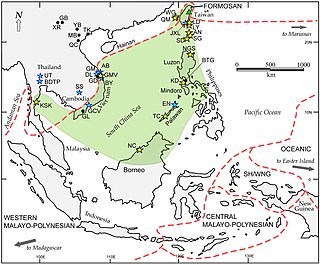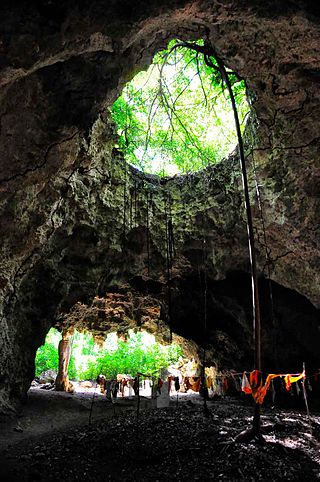Related Research Articles

Glassblowing is a glassforming technique that involves inflating molten glass into a bubble with the aid of a blowpipe. A person who blows glass is called a glassblower, glassmith, or gaffer. A lampworker manipulates glass with the use of a torch on a smaller scale, such as in producing precision laboratory glassware out of borosilicate glass.

Maritime Southeast Asia comprises the countries of Brunei, Indonesia, Malaysia, the Philippines, Singapore, and East Timor.
The Indian diaspora in Southeast Africa consists of approximately 3 million people of Indian origin. Some of this diaspora in Southeast Africa arrived in the 19th century from British India as indentured labourers, many of them to work on the Kenya–Uganda railway. Others had arrived earlier by sea as traders.
Chibuene is a Mozambican archaeological site, located five kilometres south of the coastal city of Vilanculos South Beach. The site was occupied during two distinct phases. The earlier phase of occupation dates to the late first millennium AD. The second phase dates from around 1450 and is contemporaneous with the Great Zimbabwe civilization in the African interior. During both phases of its development Chibuene was a trading settlement. Trade goods obtained from the site include glass beads, painted blue and white ceramics, and glass bottle fragments. The later phase of settlement has yielded remains of medieval structures as well as evidence of metallurgy. Crucibles have been found that were presumably used to melt gold obtained from trade with the Great Zimbabwe civilization. There is evidence that Chibuene traded extensively with the inland settlement of Manyikeni. Mozambique has jointly inscribed these two properties on their tentative version of the World Heritage List.
Indian Mozambicans form the sixth-largest Indian diaspora community in Africa, according to the statistics of India's Ministry of External Affairs. Roughly 70,000 people of Indian descent reside in Mozambique, as well as 870 Indian expatriates.

Indian Tanzanians constitute a significant minority within the demographic landscape of Tanzania, with a population exceeding 60,000 individuals of Indian descent residing in the country. Many among them are traders and entrepreneurs, and despite forming only 0.2% of the population, who of which came control over the majority of the economy. Indians also have a long history in Tanzania, starting with the arrival of Gujarati traders, and they gradually came to control the trade in Zanzibar. Several buildings from that period still stand in Stone Town, the primary trading center on the island.
Indian Ocean trade has been a key factor in East–West exchanges throughout history. Long-distance trade in dhows and proas made it a dynamic zone of interaction between peoples, cultures, and civilizations stretching from Southeast Asia to East and Southeast Africa and East Mediterranean in the West in prehistoric and early historic periods. Cities and states on the Indian Ocean rim focused on both the sea and the land.

Unguja Ukuu is a historic Swahili settlement on Unguja island, in Zanzibar, Tanzania.
The Philippines is an archipelago located in Southeast Asia and consists of 7,641 islands. Prehistoric beads are among the most significant resources deriving from the human past. They are artifacts that inform individuals about archaeological records. Beads play a vital role in Asian lives, since they were utilized as human markers to indicate a territory; moreover, prehistoric beads were significant for ancestors as well as the people who occupied the identical territory. For instance, if beads are perished or destroyed, they can be recovered archaeologically due to their durability, which allows for the preservation of these resources. Furthermore, several of the decorative pieces and tools that they possess, as well as their culture, seem to reflect this maritime characteristic. Due to the fact that beads are transportable, compact in size, and appealing to the eye, they can essentially be discovered all over the world. Tools such as choppers made of shells as well as decorative pieces like shell beads are common in Southeast Asian archaeological records due to this characteristic. Various sites have been found to contain shell beads, including Sucgang Barrio in Bohol; Sibale Island, near Surigao; Suluan island, south of Samar; Lagen Island in Palawan; and Camotes Islands.

Philippine jade culture, or jade artifacts, made from white and green nephrite and dating as far back as 2000–1500 BC, have been discovered at a number of archaeological excavations in the Philippines since the 1930s. The artifacts have been both tools like chisels and ornaments such as lingling-o earrings, bracelets, and beads.
Munsa is an archaeological site in Uganda, located in the south-eastern part of Bunyoro, and is commonly recognized by a rocky hill known by the locals as "Bikegete", which is enclosed within an earthworks system of ancient ditches. The site is approximately 5 kilometres (3.1 mi) north-west of Kakumiro township in Bugangaizi County, Kakumiro District. "Munsa" is a Runyoro(Lunyoro/Runyoro Edited by Nicholas Aliganyira Nkuuna) name that means "in the trenches". The architects of the earthworks are unknown, although it has been speculated that the site can be linked to the Bachwezi. There is no evidence for this, however, and it seems likely that association of Munsa with the Bachwezi or Chwezi is a recent development.
Njoro River Cave is an archaeological site on the Mau Escarpment, Kenya, that was first excavated in 1938 by Mary Leakey and her husband Louis Leakey. Excavations revealed a mass cremation site created by Elmenteitan pastoralists during the Pastoral Neolithic roughly 3350-3050 BP. Excavations also uncovered pottery, beads, stone bowls, basket work, pestles and flakes. The Leakeys' excavation was one of the earliest to uncover ancient beads and tools in the area and a later investigation in 1950 was the first to use radiocarbon dating in East Africa.

People first began to be interested in Malawi's prehistoric past in the 1920s. Excavations of sites in nearby countries, Tanzania and Zambia, made archaeologists believe that they may find the same type of material culture in Malawi. In the 1920s, a series of lacustrine deposits was found at the northwest end of Lake Malawi. These beds contained fragmentary fossils and were mapped by Dr. F. Dixey. These findings sparked an interest to excavate more locations in Malawi.

Maritime archaeology in East Africa spans the range from the horn of Somalia south to Mozambique, and includes the various islands and island chains dotting the map off the coast of Somalia, Mozambique, Tanzania and Kenya. Primary areas along this coast include the Zanzibar, Lamu, and Kilwa Archipelagos. Although East African societies developed nautical capabilities for themselves, most of the maritime artifacts point to external merchants from Mediterranean cultures like Egypt and Greece, Indian and Chinese from South and East Asia in the early stages, to the great European powers during the Ages of Colonization and Imperialism.
Chantal Radimilahy is an archaeologist and museum curator from Madagascar. She was the first woman from the country to earn a PhD in Archaeology and the first woman to direct the Museum of Art and Archaeology at the University of Antananarivo.
Kissi is a Burkinabe archaeological site located in the Oudalan Province of Burkina Faso, near the lake Mare de Kissi and near the borders of Mali, Niger, and the Niger River. Occupied during the Iron Age, Kissi provides evidence for Iron Age textiles, beads, and mortuary practices. The site also has unique ceramic and settlement sequences to it, with clusters of mounds located throughout the site. Radiocarbon dating dates the specific occupation of the site from 1000 BC to 1300 AD.

Kuumbi Cave is an archaeological site located in Kusini District, Unguja South Region of Tanzania. It has been important in determining patterns of human occupation since its formation over 20,000 years ago. Unusual lithic and ceramic finds dated within the last 2,000 years make Kuumbi Cave a unique site. Its name in Swahili, Pango la Kuumbi, translates to "Cave of Creation".
Bosutswe is an archaeological site at the edge of the Kalahari Desert in Botswana on top of Bosutswe Hill. The site can be dated back to around 700 AD. The location of Bosutswe makes it easy for archaeologists to study as the record of the site is continuous. It is believed that the area was occupied consistently for around 1000 years. It was known for its advanced metalworking which first appeared around 1300 AD, which is known as the Lose Period. The Lose Period is named after the elite class that can be found in the area.
Sri Lankans in Japan consist of Sri Lankan migrants that come to Japan, as well as their descendants. In December 2023, there were 46,949 Sri Lankans living in Japan. They are the fourth largest nationality group from South Asia after Nepalis, Burmese and Indians.
The Kisalian Graves are a series of burial sites located in the Northern part of the Upemba Depression, Democratic Republic of the Congo. They are a part of a larger collection of archaeological sites all dating back to the Iron Age of the region.
References
- 1 2 Wood, Marilee (2012). "Interconnections: glass beads and trade in southern and eastern Africa and the Indian Ocean - 7th to 16th centuries AD". Azania: Archaeological Research in Africa. 47 (2): 248. doi:10.1080/0067270X.2012.680307. ISSN 0067-270X. S2CID 162211326.
- ↑ Katsuhiko, Oga; Gupta, Sunil (2000-01-01). "The Far East, Southeast and South Asia: Indo-Pacific Beads from Yayoi Tombs as Indicators of Early Maritime Exchange". South Asian Studies. 16 (1): 73–88. doi:10.1080/02666030.2000.9628581. ISSN 0266-6030. S2CID 191984538.
- ↑ Gupta, Sunil (1999–2000). "From Eastern Indian Ocean to the Yellow sea interaction sphere: Indo-Pacific beads in Yayoi Japan" (PDF). Purātattva. 30: 93–97.
- ↑ Pion, Constantin; Gratuze, Bernard (2016-06-01). "Indo-Pacific glass beads from the Indian subcontinent in Early Merovingian graves (5th–6th century AD)". Archaeological Research in Asia. Asia's Maritime Bead Trade. 6: 51–64. doi:10.1016/j.ara.2016.02.005. ISSN 2352-2267.
- ↑ Kanungo, A.K. 2004. Glass Beads in Ancient India and Furnace-Wound Beads at Purdalpur: An Ethnoarchaeological Approach. Asian Perspectives 43(1):123–150.
- ↑ Francis, Peter (1990). "Glass Beads in Asia Part Two. Indo-Pacific Beads". Asian Perspectives. 29 (1): 1–23. ISSN 0066-8435. JSTOR 42928207.
- ↑ Wood, Marilee; Dussubieux, Laure; Robertshaw, Peter (2012-06-01). "The glass of chibuene, mozambique: New insights into early indian ocean trade". South African Archaeological Bulletin. 67: 59–74.
- ↑ Wood, Marilee; Panighello, Serena; Orsega, Emilio F.; Robertshaw, Peter; van Elteren, Johannes T.; Crowther, Alison; Horton, Mark; Boivin, Nicole (2017). "Zanzibar and Indian Ocean trade in the first millennium CE: the glass bead evidence". Archaeological and Anthropological Sciences. 9 (5): 879–901. doi: 10.1007/s12520-015-0310-z . hdl: 11858/00-001M-0000-0029-7CD9-0 . ISSN 1866-9557. S2CID 49586474.
- ↑ Wood, Marilee (2012). "Interconnections: glass beads and trade in southern and eastern Africa and the Indian Ocean - 7th to 16th centuries AD". Azania: Archaeological Research in Africa. 47 (2): 248. doi:10.1080/0067270X.2012.680307. ISSN 0067-270X. S2CID 162211326.
- ↑ Solheim, Wilhelm G.; FRANCIS, PETER (2003). "Review of ASIA'S MARITIME BEAD TRADE, 300 B.C. TO THE PRESENT, PETER FRANCIS, JR". Journal of the Malaysian Branch of the Royal Asiatic Society. 76 (2 (285)): 129–132. ISSN 0126-7353. JSTOR 41493507.
- ↑ Saju, M. T. (November 17, 2020). "'Indians made glass blown beads 2,500 years ago'". The Times of India. Retrieved 2021-03-06.
- ↑ Carter, Alison Kyra (2016-06-01). "The Production and Exchange of Glass and Stone Beads in Southeast Asia from 500 BCE to the early second millennium CE: An assessment of the work of Peter Francis in light of recent research". Archaeological Research in Asia. Asia's Maritime Bead Trade. 6: 16–29. doi:10.1016/j.ara.2016.02.004. ISSN 2352-2267.